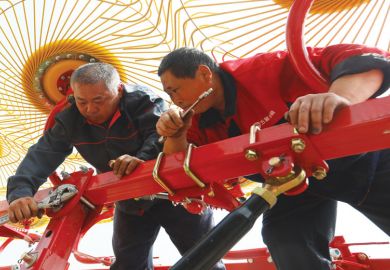A sandwich structure comprises a relatively thick but light core material glued between two relatively thin, but strong and stiff, sheets.
Historically, the concept of using two cooperating face sheets separated by a distance is first thought to have been discussed by a Frenchman, Duleau, in 1820, and later by Fairbairn, in 1849, in his account of the construction of the Britannia and Conway tubular bridges.
Some use of the sandwich concept was made in the early 20th century, though it was the Second World War and the advances in adhesive technology that brought sandwich construction to the fore. The Mosquito aircraft, produced in England in the Thirties and Forties, saw mass production of sandwich panels using veneer face sheets and balsa wood core materials for the aeroplanes' structures.
From those beginnings, the concept has received relatively widespread application. The construction is advantageous in terms of performance and cost, and is used by a variety of industries, including aircraft, spacecraft, ships, boats, storage tanks, trains, buses and lorry trailers.
The Journal of Sandwich Structure and Materials was started in 1999, mainly due to the pioneering efforts of the editor-in-chief, Jack Vinson of the University of Delaware. It was argued that while the concept was beginning to find widespread acceptance in several industrial contexts, there were still gaps in knowledge about more efficient use of the materials. There was also a feeling that there needed to be a specialist forum for the exchange of ideas.
So the primary purpose of the journal is to "provide a means of communication to fellow engineers and scientists by providing an archival record of developments in science, technology and professional practices of sandwich construction throughout the world".
The journal's coverage is impressive. The editorial board comprises academic experts from Denmark, Israel, Italy, Japan, Sweden, Switzerland, the UK and the US, and the papers' authors are even more geographically diverse. Furthermore, the contents of papers published so far reflect favourably on the stated editorial policy.
Papers have dealt with fundamental aspects of mechanics; numerical techniques, such as finite element analysis; process modelling and the issues governing production; failure modes and the damage models to predict these ultimate service limits; safety and reliability assessment; optimisation techniques and selection of the best design parameters for a purpose; fatigue, fracture and long-term endurance and durability issues; experimental modelling and measurement of intrinsic properties of the materials and structure topology; and non-destructive examination of in-service structures and the related issues of repair. The quality is uniformly high because papers are selected after rigorous refereeing.
The journal is included in a number of indexing and abstracting services, including Academic Search, Aerospace Database International, Applied Mechanics Reviews, Engineered Materials Abstracts and the Science Citation Index. It is a must for educational establishments with aerospace, mechanical engineering, civil engineering, chemical engineering or ocean engineering degree and postgraduate programmes.
R. Ajit Shenoi is research professor in engineering, Southampton University.
Journal of Sandwich Structures and Materials
Editor - Jack R. Vinson
Publisher - Sage, Bimonthly
Price - Institutions £635.00
ISSN - ISSN 1099 6362
Register to continue
Why register?
- Registration is free and only takes a moment
- Once registered, you can read 3 articles a month
- Sign up for our newsletter
Subscribe
Or subscribe for unlimited access to:
- Unlimited access to news, views, insights & reviews
- Digital editions
- Digital access to THE’s university and college rankings analysis
Already registered or a current subscriber? Login



